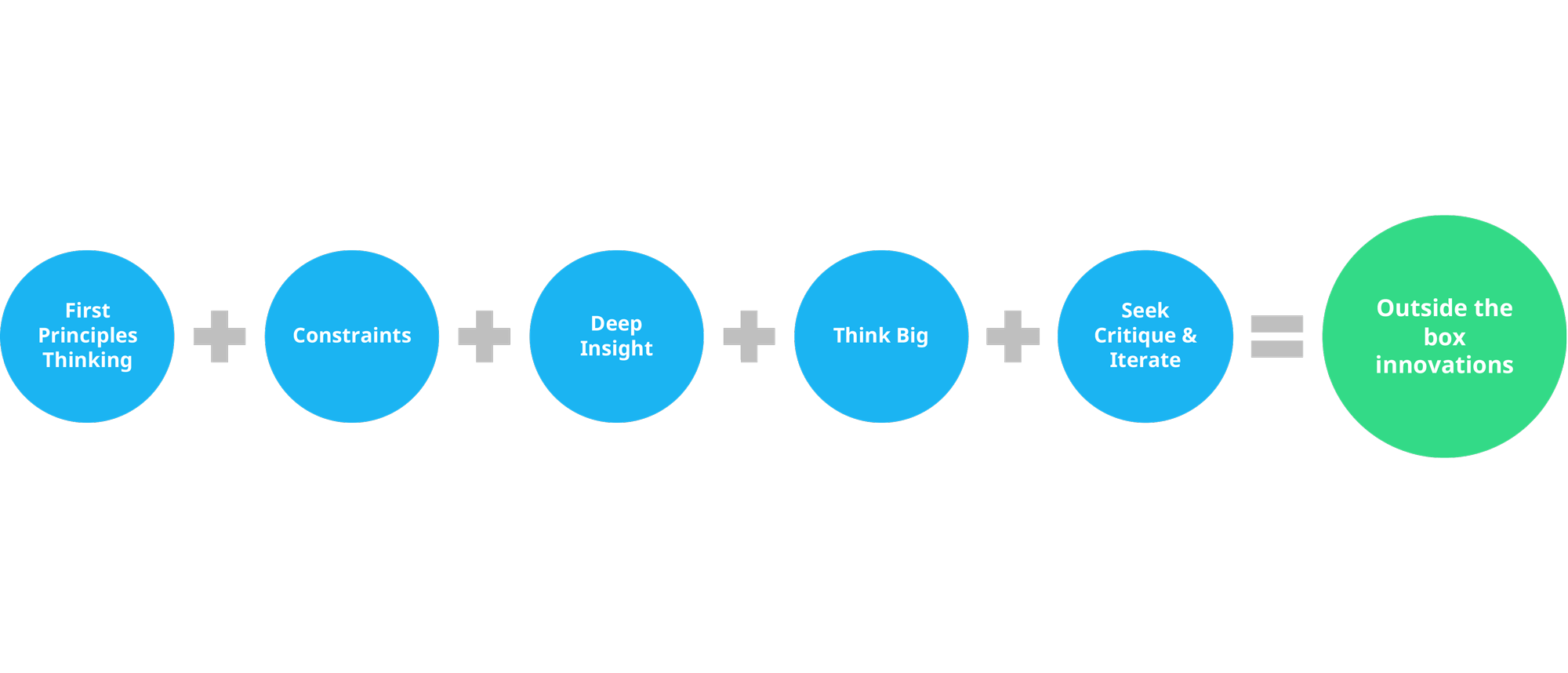Here’s how you can come up with outside the box innovations
If you’ve been working in innovation for at least some time, you’re probably sick and tired of hearing people talk about “thinking outside the boxâ€, or the need to create “outside the box innovationsâ€.
The phrase has become one of the most overused clichés out there. However, just like so many other clichés, there’s an underlying reason for this being the case even though I personally dislike the term.
While many of the most impactful innovations of our time are based on advanced technology and decades of research and development work, there are likely just as many that are actually just novel but surprisingly simple approaches to solve a known problem.
These kinds of innovations offer some of the best returns on investment given their simplicity, so the ability to systematically create “outside the box innovation†is an incredibly valuable skill.
There is, without a doubt, lot of creativity involved, but it’s without a doubt a skill that can be learned. Let’s dig a bit deeper and investigate some simple techniques you can use to boost your ability to come up with these “outside the box ideas†that might just lead to breakthrough innovations.

How are outside the box innovations born?
If you’ve ever participated in an ideation workshop, it’s quite likely that you’ve heard a facilitator tell the participants that “there are no bad ideasâ€.
However, that’s simply not true. There are tons of bad ideas, and we’ve all surely came up with our own fair share of those.
There are ideas that are ignorant, or just don’t make sense. There are ideas that are unrealistic or too ambitious. There are ideas that aren’t ambitious enough.
Knowing when an idea is good, and when it’s actually bad, however, isn’t easy. That is especially the case if you’re aiming for big, truly novel ideas.
A good “outside the box idea†solves a real problem by identifying something that others haven’t, and is thus usually seen as controversial, or even irrational.
A good “outside the box idea†has identified something that others haven’t, and is thus usually seen as controversial, or even irrational.
To get to one, you have to be curious and approach the problem with a beginner’s mind, or shoshin as it’s known in Zen Buddhism. However, you also need to understand the problem, and the context in which it is, deeply.
Ironically, most ideation workshops are structured in ways that lead mostly to superficial problem solving and groupthink.
So, if workshops won’t help you come up with these ideas, the question then remains, how do you actually get to one?
Creating outside the box innovations
As mentioned, while the process of coming up with innovative ideas always involves some creativity, it’s just as much a science as it is an art, unlike what many so called creativity experts would have you believe.
Depending on what kind of ideas you’re aiming for, the process might look a bit different, but the ingredients in the recipe are always the same. Let’s look into them in more detail.
1. First principles thinking
The first, and perhaps the most important, ingredient is first principles thinking, which is basically the logical next step from having a beginner’s mindset.
The core idea is that you break the problem or idea into the smallest, most fundamental truths that you really know to be true, and then start to work up from there in a hyper-rational manner.
While this sounds simple, we almost never actually bother to do this because it’s so laborious.
Here’s a short video of Elon Musk explaining the concept.
So, to apply this method to your idea, ask the following questions:
- What do we absolutely certainly know to be true?
- What is universally considered to be true, but necessarily isn’t?
- What could be possible, but currently isn’t being done for one reason or another?
- Has someone else solved a similar problem in another industry or domain?
These will help you to move from the simplistic “this can’t be done†to “maybe we could do this, but it would require us to…â€
2. Embrace constraints
One of the key problems with the “think outside the box†saying is that in real life, there is always a box.
In real life, there is always a box.
You probably live in a country that has laws. You probably have a budget. Your industry most likely has rules and regulations. You probably have a personal and corporate code of conduct and ethical standards. Your customers probably have limited funds to pay for your products and services.
While these constraints might limit your options, knowing what they are can actually help you tremendously.
There are a few key reasons for this:
- Constraints help you understand the problem better
- They force you to be creative
- They can be turned into a source of competitive advantage
Let’s start from the first one.
It’s one thing to, for example, build a car that is simply able to move from A to B on four wheels, but a completely different kind of challenge to build one that complies with all the laws and regulations related to safety, emissions, and so on, that customers actually enjoy, and at a price they are able to afford.
Without fully understanding the context of the problem, you’re making educated guesses at best.
They key here is understanding the difference between hard constraints and soft constraints.
Laws are the classic example of hard constraints. You likely won’t be able to change them, so you’ll just have to adapt to them.
However, even laws aren’t always truly hard constraints. For example, different countries have different laws, so even if a law prevents your innovation from creating value, you might be able to continue working on it in a different country.
Thus, most constraints are actually soft constraints. For example, you can always try to get more budget, or find ways to solve the same problem in a more affordable way.
This is where first principles thinking again comes into play. It helps you figure out which constraints you simply have to live with, and which ones you can break or get around to make your innovation happen.
Furthermore, constraints are never just a negative. According to recent research, innovators actually usually succeed because of constraints, not despite of them. With no or very limited constraints, it’s easy for complacency to kick in, and for innovators to simply go for the most obvious idea.
As Airbnb co-founder & CEO Brian Chesky said in a recent interview, “constraints create creativityâ€. According to Chesky, without the constraints of being a small startup, he says he probably wouldn’t have done half the creative decisions he ended up making that went on to lay the foundations for Airbnb’s remarkable success so far.
Constraints create creativity.
– Brian Chesky, Airbnb Co-founder & CEO
What’s more, there are situations like the current crisis where virtually everyone faces the same constraints. In these kinds of environments, constraints can even become a source of competitive advantage.
For example, if a country introduces more aggressive environmental legislation, it means that that specific market is likely to have more demand for new, more environmentally friendly, products and services, which is obviously a big opportunity for those who are able to adapt to the changing situation. The situation can thus become a source of competitive advantage against those who aren’t able to adapt to the changing circumstances as quickly.
3. Dig deeper
This brings us to our next key ingredient. To fully understand the context in which you operate, and the constraints therein, you need to dig deep.
Yes, you need to understand the industry, and the technology, but even more importantly, you need to intimately understand the problem you’re looking to solve, or help others solve.
In practice, that typically means going in the field and observing how your potential customers are currently trying to solve the same problem or get the same job done.
Especially in larger companies, many people have a tendency to overemphasize quantitative research. When you have thousands of customers, it’s very quick and easy to just send them a survey and see what the results are.
However, while quantitative research is a useful tool, especially later on, you really need to focus on qualitative research in the beginning as it allows you to acquire in-depth understanding of the problem and of your potential customers.
The Jobs to Be Done theory is an extremely helpful tool here.
Together with first principles thinking, this approach helps you to understand what “Job†your customers are really looking to get done and compare that to the challenges they’re currently facing in the process of doing so.
As the age-old saying goes, people don’t want a quarter inch drill, they want a quarter inch hole in the wall.
In practice, a good starting point for doing this is the 20 Interview Rule. The idea is that you need roughly 20 in-depth interviews to truly understand the problem you’re trying to solve, and to narrow in on your positioning.
When conducting these interviews, focus on trying to dig out the root causes of people’s problems, as well as their deeper, underlying desires as opposed to what’s clearly evident on the surface. The 5 Whys Process is a simple and effective way for doing just that.
4. Think bigger
As Astro Teller, the head of Google X, has said: it’s actually often paradoxically easier to be 10x better than it is to be 10% better.
There is naturally a time and a place for those 10% improvements, but if you’re looking for outside the box ideas, aiming for 10% better will only guide you down the wrong path.
This again comes back to the power of constraints.
If the target is to be 10% better, you’ll inevitably take an approach of doing more of the same, just with slightly more resources than before, or with slightly improved processes.
However, if you need to be 10x better, you can’t just do more of the same. You have to think differently and find novel ways to approach the problem to achieve that goal.
A great example of this that we’re all familiar with it, and where many companies have invested huge amounts of resources in the last decade, are smartphone cameras.
Early on we used to just see “simple†hardware improvements, like the number of megapixels rising every year, to improve image quality. That traditional approach had been around for as long as there have been digital cameras.
However, in the last few years, companies were no longer able to make meaningful improvements with the same approach without making sacrifices in other areas of their phone design. A new way of approaching the problem of taking better photos was clearly needed, and that’s where the use of software came in.
Now the best cameras aren’t the ones with the most megapixels, but those that best use software to process the images that the camera takes. It’s now even possible to take smartphone photos that many people have a hard time distinguishing from photos taken with professional cameras that are nearly 10 times more expensive than the phone, which is obviously a huge leap from where smartphone cameras were prior to this shift just a couple of years ago.
Keep in mind that the smartphone industry is one of the most competitive industries out there with dozens of huge companies involved. In most other industries, it will likely be much easier to make this kind of leaps.
5. Constantly seek critique
As Tesla and SpaceX CEO Elon Musk says, one of the biggest mistakes people make is to not actively seek negative feedback and critique for their ideas.
It’s easy to just ask your customers, friends, or colleagues: “What do you think of this?â€, and when you do, you’ll usually just hear a variation of “Well, it’s nice and I really liked this part of it…â€.
That all good and well for boosting your ego, but doesn’t really help you improve the product, service or idea.
However, getting truly constructive feedback isn’t easy. When people know that you’ve built something, they want to be nice and polite and don’t want to hurt your feelings by critiquing it.
So, in general, to get this kind of feedback, you need to actively ask for it. So instead of just asking for general feedback, ask specifically what users or customers don’t like, or what they think could be improved.
Let’s face it: no idea is perfect when someone first comes up with it. It takes a lot of work and iteration to refine and perfect it, and constructive feedback and real-world observations are a key part in achieving that.
Putting the pieces together
So, to conclude, coming up with outside the box ideas and innovations isn’t black magic, or purely a matter of getting lucky. It’s a skill that can be learned.
That is to say, the key ingredients of these so called outside the box innovations are usually the same. There is a repeatable process that you can harness to come up with and refine these kinds of ideas.
That obviously doesn’t mean that you’d succeed every time, or that it would be easy.
It’s very unlikely that you could come up with these ideas on the spot. You need to put in quite a bit of work and remain humble and open-minded.
You also have to be prepared to iterate the ideas based on what you learn, know when to persist, when to pivot, and when to simply abandon an idea.
And remember to keep in mind that it’s actually usually better to get to know the box, than it is to just try to “think outside of itâ€.
This article was originally published on Viima’s blog.
NEVER MISS ANOTHER NEWSLETTER!
LATEST BLOGS
Credit Card Shenanigans
It must be great to be in the credit card business in the United States. Demand is relatively inelastic and regulation is lax, so you can charge whatever you want for an interest rate, increase your fees once or twice a year, and make additional money off cash withdrawals and foreign exchange transactions.
Read MoreBuilding an Experience
As people become ever more immune to traditional advertising and marketing, branding will become more important. Branding is all about building an emotional connection with customers. Making the decision to follow a strategy focused on building a brand is not without peril, however, as it means that you will have to choose to not do certain things, like pursue a low price strategy.
Read More- « Previous
- 1
- …
- 4,132
- 4,133
- 4,134



